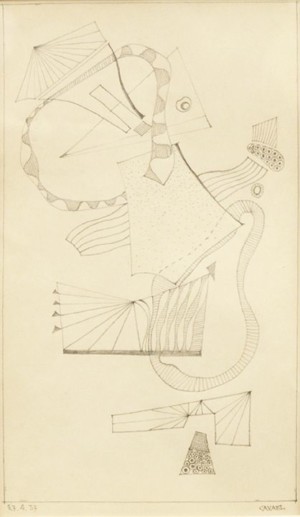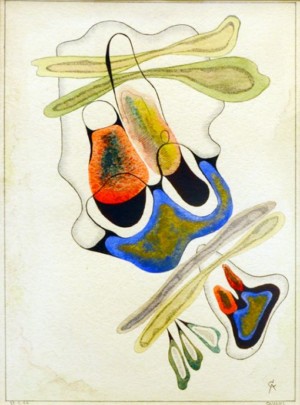The artist Rolf Cavael was born in 1891 in Konigsberg, Prussia, which is now Kalininigrad. His father was an architect and his mother was a children’s counselor. Following his mother’s death in 1907, he moved to Strasbourg, where he attended the Lycee Technique.
The family moved several times after this, and Cavael was mobilized for the army in 1919, but only spent a short amount of time in the military, as World War I ended soon after.
In 1920, Cavael moved to Berlin, where he was able to make contact with people involved in movie production, and he was hired as an assistant to a director. Following his strong artistic inclinations, and with the urging of his father, he entered the Ecole Stadel in Frankfurt, and received a scholarship to study applied graphic arts and typography.
The following years were productive for Cavael. In Frankfurt, he taught at the Städtische Handelsschule in the Applied Graphic Art Department, and also taught Abstract painting. He married Dorothea Schemel in 1930, and in the same year, he visited the Russian painter and art theorist Wassily Kandinsky at the famous Bauhaus school in Dessau. They formed a strong relationship, which continued after Kandinsky moved to Paris. It was also in 1930 that he lost his professorship due to an emergency decree of Chancellor Brüning. Cavael then moved to Berlin and worked as an independent artist.
The changing political situation in Germany presented complications for Cavael, as his 1933 joint show with Joseph Albers in the Castle Braunschweig was closed on the day of its opening and the two artists were banned from exhibiting in Germany . Shortly after, Joseph Albers immigrated to the United States, while Rolf Cavael remained in Germany, moving to Garmisch where he attempted to continue his work despite the restrictions.
Despite halting his exhibitions in 1936, Cavael was denounced and apprehended by the Gestapo. He forced to spend several months in Dachau concentration camp, but he fortunately survived the experience and was released within a year. Following his detainment, the previous ban on his exhibitions was extended to the production of work as well. His art was considered “decadent” by the Nazis and excluded from the Reichskulturkammer, the Reich’s Chamber of Culture. Throughout his time in the camp and during the war, he continued to work in secret.
Following the end of the war, Cavael was allowed to continue his work openly. In 1949 Cavael, along with six artists including Willie Baumeister, Fritz Winter and Rupprecht Geiger, formed the ZEN 49 group, originally called the Gruppe der Gegenstandslosen or Group of Non-Objectivists. Hann Trier and Hubert Berke joined the group shortly after its formation, bringing up the total number of artists to nine. The name ZEN 49 was chosen in reference to Zen Buddhist philosophy. Though the artists were inspired by the general philosophy, they did not study it exclusively, and as such included the date 49 to identify the group as not solely concerned with this philosophy. This group of artists was dedicated to creating a new art for post-war Germany and was supported by the art critic John Anthony Thwaite and art historians Ludwig Grote and Franz Roh. Their first exhibition was in 1950 in the Central Art Collecting Point in Munich, and they continued to exhibit together until 1955, with several retrospective exhibitions held until the 1990’s.
In 1954, he moved again to Munich. He began working at as a guest professor at the “Hochschule für Bildende Künste” in Hamburg and more permanently at theMunich “Volkshochschule” from 1956-1973. In 1953, he was awarded the Prix de l’Art of Munich. He also was invited to show at the 29th Bienalle in Venice and at the International Triennal of Graphic Art in Switzerland, where he was awarded the First Prize. Over the following years the “Lenbachhaus” in Munich, the “Kestnergesellschaft” in Hanover and “Kunsthalle” in Baden Baden all showed his work in solo exhibitions.
Rolf Cavael was awarded Lovis-Corinthe Prize from the “Künstlergilde” in 1979 and the first Prize Cross of Merit of the Federal Republic of Germany. He died later that same year. Rolf Cavael was one of the most important advocates for non-representational painting in Germany.
Showing all 2 results
-
$500,010,000.00




